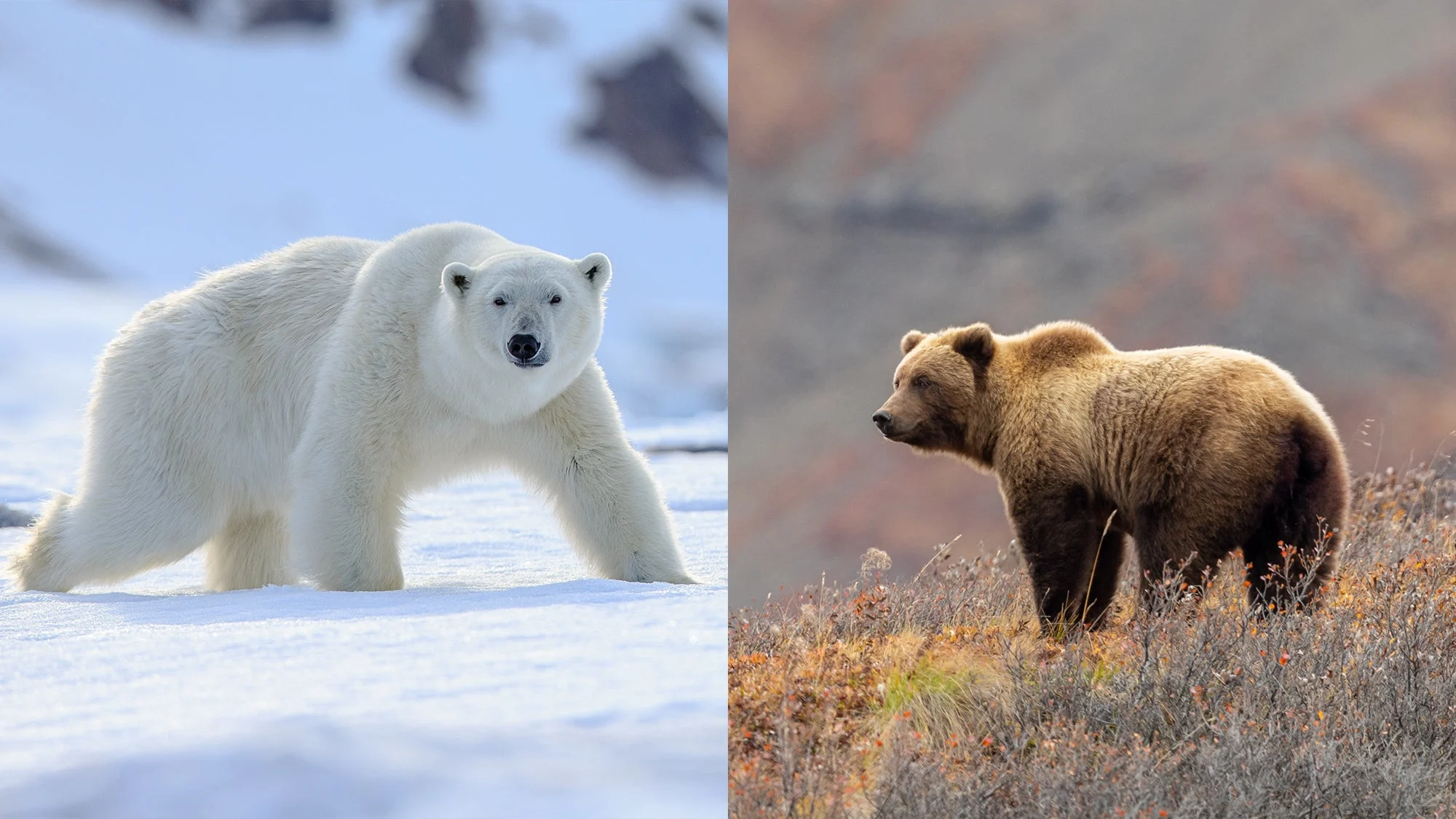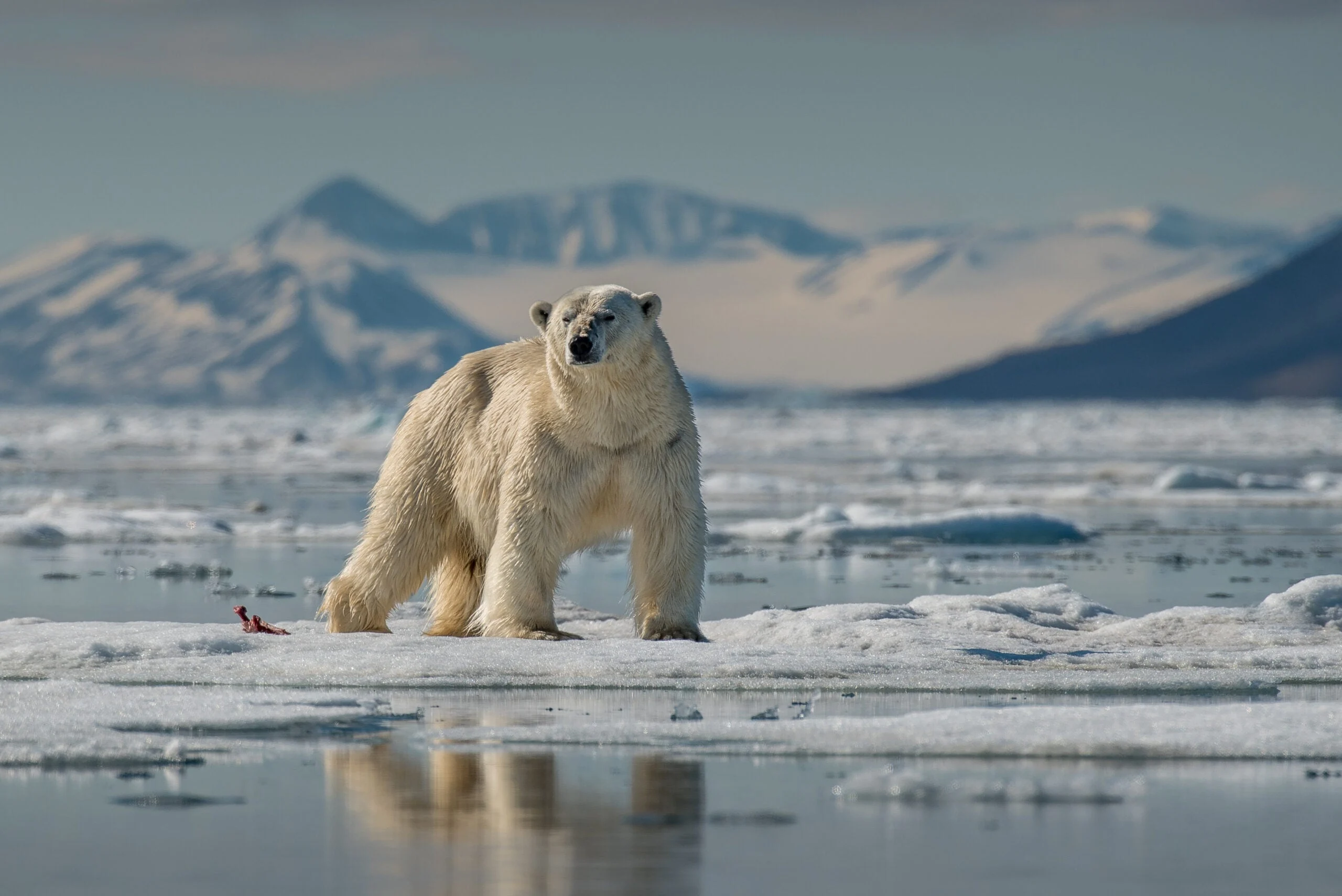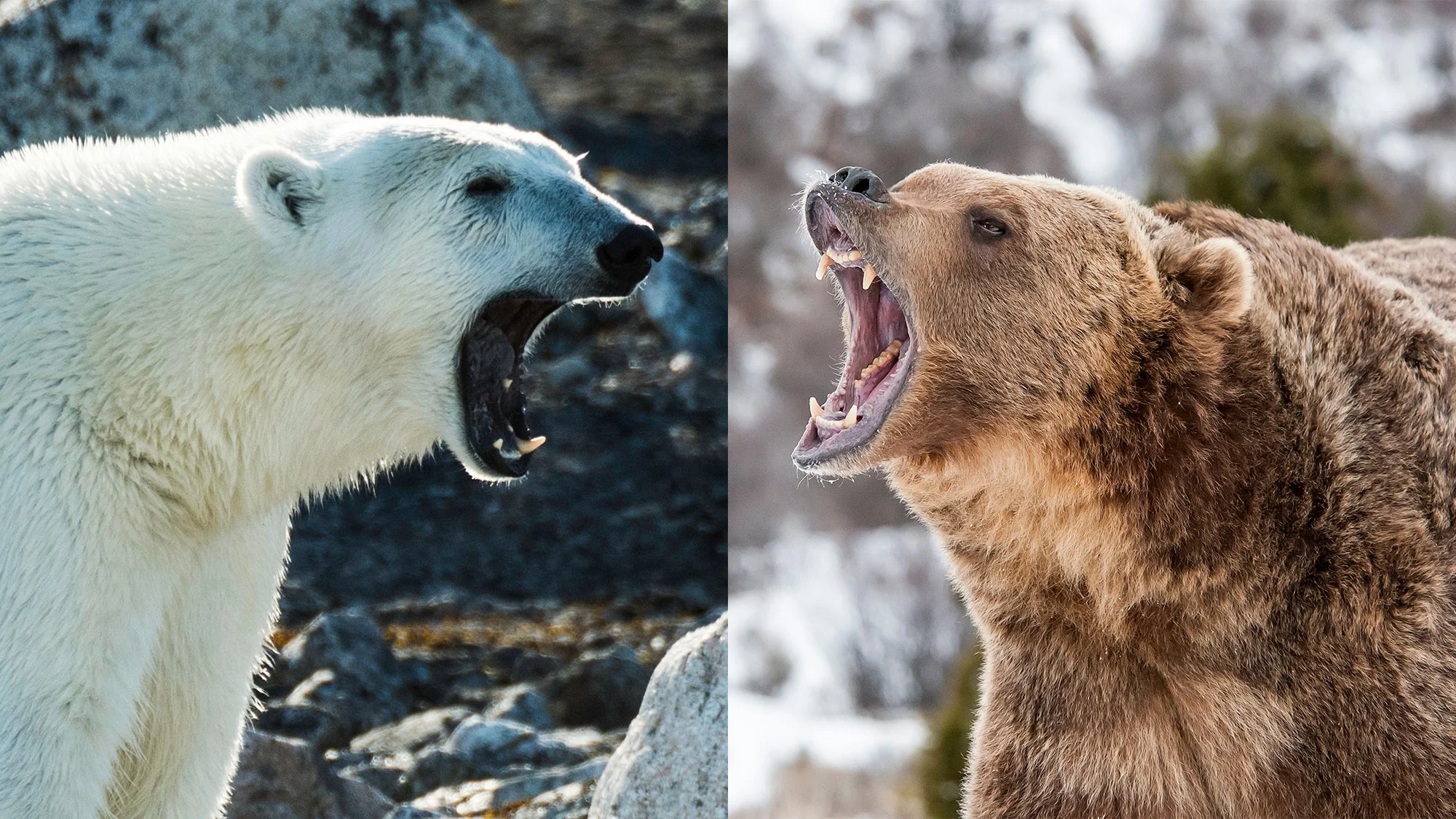Genetically, polar bears and grizzly bears aren’t all that different. Scientists believe that polar bears split from grizzly bears between 250,000 and 130,000 years ago. The two species are actually the most closely related out of all the bears. Still, there are some striking differences. Each bear has evolved to adapt to their own environments, with specific diets, habits, and physical traits. Here’s a quick rundown of the differences between a polar bears vs grizzly bears—plus the odds of one winning in a fight over the other.
Polar Bear vs. Grizzly Bear: Key Facts
Polar bears are larger than grizzly bears on average, but the largest brown bears are nearly as big as the largest polar bears.
Polar bears’ paws are better suited for swimming and walking on ice, while grizzly paws are better for killing prey and digging.
Grizzly bears hibernate. Only pregnant female polar bears will hibernate, and they don’t truly hibernate compared to other animals.
Grizzlies have smaller home ranges than polar bears.
Polar bears eat way more meat than grizzly bears.
As of this writing, you cannot hunt polar bears or grizzly bears in the Lower 48 states of the U.S.
Table of Contents
Polar Bear vs. Grizzly Bear: Physical Differences
Polar Bear vs. Grizzly Bear Behavior
Hunting Grizzly Bears and Polar Bears
Polar Bear and Grizzly Bear Hybridization
Which One Would Win in a Fight?
Polar Bear vs. Grizzly Bear: Physical Differences

Polar bears are bigger and heavier than grizzlies; they also have longer snouts, smaller ears, and shorter legs. Adobe Stock / Field & Stream
Let’s start with the obvious: Polar bears have white coats (the fur is actually transparent to let the sun warm their white skin). Grizzly bears have brown coats, often with blonde highlights and/or a silver-tipped appearance. In general, polar bears are bigger than grizzlies, starting around 8 feet and reaching nearly 10 feet in length. The largest male polar bears can weigh up to 1,700 pounds, but on average, they weigh between 600 and 1,200 lbs. The biggest grizzlies—and here we are talking mainland grizzlies as opposed to coastal brown bears—are only a little smaller than the biggest polar bears, but grizzly size varies, starting around 4.5 feet and maxing out just over 9 feet long. Full-grown male grizzlies weigh upwards of 700 pounds on average. Coastal brown bears, of which there are several subspecies, including Kodiak bears, can weigh nearly as much as polar bears.
A polar bear’s skull and nose are also longer than a grizzly’s. But grizzlies have longer claws than polar bears—which are better for digging. A polar bear’s paws are better suited for swimming, and the pads are covered in fur to give a firmer grip on ice. Polar bears also have smaller ears and shorter legs than a griz. Both bears have a life expectancy of around 25 years, and both bears can walk on their hind legs
Polar Bear vs. Grizzly Bear Behavior

A polar bear hunts for seals out on the ice. Adobe Stock
Not all polar bears hibernate—just pregnant females. And compared to other bears, female polar bears do not hibernate as deeply. Grizzlies on the other hand hibernate between two and seven months each year, depending on the climate. Female polar bears and grizzlies raise their young for two years before setting them off to live on their own. The males of both species are not involved in raising cubs.
Grizzlies are more omnivorous than polar bears with only 10 percent of their diet coming from meat. Polar bears would probably eat more plants if they had access to them. Instead, they subsist mostly on meat from marine mammals like seals and whales. Polar bears will occasionally eat birds’ eggs and other things they can scavenge when food is tight.
Grizzlies’ home ranges are between 50 and 150 square miles for females and up to 600 square miles for males. Polar bears can cover a lot more ground, traveling between 19,000 and 135,000 square miles depending on available food and mates. Polar bears are not territorial, and in general, neither are grizzlies.
Hunting Grizzly Bears and Polar Bears
Polar bear hunting is tightly regulated and usually based on harvest quotas for communities that live in polar-bear country. These hunts can cost $50,000 or more and are nearly impossible to pull off without an outfitter, but success rates are high. Polar bears are hunted from late February into the spring during either the “light” season (when the sun never sets) or the “dark” season (when the sun never rises). Temperatures can reach below -25 degrees F on these hunts. Outfitters use dog sleds to travel on the ice in search of bears and snowmobiles to pack in and out of base camp.
Grizzlies can be hunted in Alaska, the Kamchatka peninsula in Russia, and one Canadian province, the Yukon. They cannot be hunted anywhere in the Lower 48. Most nonresident grizzly hunts are hosted by outfitters. Hunters take grizzlies both in the spring and fall over bait and via spot-and-stalk with bows or rifles. Prices start at about $12,000 and go up from there.
Polar Bear and Grizzly Bear Hybridization
aren’t creatures from Napoleon Dynamite’s sketchbook. Grizzly/polar-bear hybrids pop up every now and then where the two bear species’ ranges overlap—and because of a warming Arctic, these ranges are overlapping more and more.
As noted, the bears are closely related, and they follow similar mating schedules. During the spring, male grizzly and polar bears search far and wide for mates. In some cases, they end up in areas where there aren’t any of their own kind, and occasionally mate with female bears of the other species. Unfortunately, hybrid bears are not well adapted to either grizzly bear or polar bear habitats.
So, Which One Would Win in a Fight?

Adobe Stock / Field & Stream
The question on everybody’s mind is which one of these huge bears would win if it came down to a fight. With polar bears being bigger and more meat-focused, they seem like a shoo-in. But according to a study in 2015
, polar bears are more likely to walk away from duking it out with a grizzly.
Researchers observed polar bears and grizzlies at the site of a beached whale carcass and found the polar bears to walk away when challenged. This is likely a smart calorie-saving decision on the part of the polar bear. (They know what it’s like to go without food for a long time.)
Read Next: Watch 5 Epic Battles of Alligators vs Pythons
Whatever the case, were these two animals to face off, each has its own advantage. Based on size and strength, it’s game over for the griz in a wrestling match, especially if the polar bear could get the grizzly in the water. But a grizzly has some pretty nasty claws, and in a stand-up boxing match, they would definitely have a chance. Male grizzlies have actually been known to kill denning female polar bears, even when the females were bigger. But in a fair fight, you’d be smart to bet on the polar bear.
Frequently Asked Questions
Which bears are most aggressive?
It depends on the situation. Polar bears can be very aggressive hunters because that’s how they get the bulk of their food. If you’re the only prey around for miles, a polar bear is going to eat you like a Klondike bar. Grizzly bears are known to be aggressive when defending cubs or cached food, but the bulk of their diet comes from foraging.
Is the polar bear the strongest bear?
Yes. They’re the largest bear, too. Polar bears have a bite force of around 1,200 psi. Grizzlies are right behind them with a bite force of 1,160 psi. Polar bears are also strong swimmers, and they can travel thousands of miles per year.
What’s the biggest bear ever recorded?
The biggest bear ever is the Arctotherium angustidens of South America. This prehistoric bear species weighed nearly 4,000 pounds and stood between 11 and 14 feet tall on its hind legs. In modern times, the biggest bear on record was a polar bear taken in 1960. It weighed over 2,200 pounds and stood nearly 12 feet on its hind legs.






